|
After
the Manchu-Qing* rulers seized control of China in 1644,
they moved quickly to assert authority over the dominant
Han Chinese population and established a dress code.
Regulations codified dress for the imperial family,
the Qing court and court officials, distinguishing the
ruling elite and government from the general population.
Women dressed according to the rank of their husbands.
*
The Manchu were nomadic people, ethnically distinct
from the majority Han population who had ruled during
the preceding Ming Dynasty. See Timeline of dynasties
for an overview of Chinese history.
Timeline
of dynasties
| 1368-1644 |
Ming |
| 1644-1911 |
Qing
(pronounced Ch'ing) |
| 1911-1949 |
Republic
of China |
| 1949- |
People's
Republic of China |
Court
robes
The ornamentation of formal (chaofu) and semi-formal
(jifu) court robes included the dragon motif
together with a decorative representation of the Chinese
conception of the cosmos. The dragon symbolised the
emperor, known as the Son of Heaven, and permission
to wear the robe was given by him. Those who passed
the civil service examinations and attained the status
of a government official were also granted the privilege
of wearing court robes. Rank was further distinguished
by a hierarchy of colour and ornamentation.

Apricot-yellow semi-formal dragon
robe (jifu), silk and gold-wrapped thread
embroidery on gauze weave silk, made in China in
the 1800s. Powerhouse Museum collection. Purchased
with funds given by Ken and Yasuko Myer, 1989. Photo
by Penelope Clay. |
The
twelve symbols of sovereignty
Probably as early as the Zhou dynasty (11th-3rd century
BC), the twelve Chinese symbols of sovereignty appeared
on the sacrificial robes of the Son of Heaven…
In 1759 the twelve symbols were reserved exclusively
for the robes of the Son of Heaven. As a symbolic interpretation
of the universe, these symbols of imperial authority
assumed a cosmic significance and represented the emperor
as the ruler of the universe.
(Pang, 1989: 38)
Adapted
from (Pang, 1989: 39) Courtesy: National Gallery of
Victoria.
Activity
1. Print out the twelve symbols of sovereignty and colour
where indicated. Look carefully at the formal court
robes presented and try to identify any of the symbols.
2. Draw a medallion for a court robe you have been asked
to design for a Chinese official from the Qing dynasty
in a play.
Surcoats
Surcoats worn by the imperial family displayed round
dragon medallions. The emperor also granted the privilege
of wearing these medallions to certain individuals.
In contrast, civil and military officials displayed
square court insignia badges with the appropriate bird
or animal identifying their rank.
In
Chinese cosmology a circle represents heaven and a square
represents earth. The dragon symbolises the emperor,
who was regarded as the Son of Heaven.

Woman's surcoat (longgua):
This surcoat was worn over a semi-formal dragon
robe (jifu) by a court concubine or noblewoman.
It is ornamented with dragon medallions which also
contain auspicious symbols of clouds, Buddhist swastikas,
and bats symbolising happiness. Tossed in the waves
of the sea are Buddhist symbols such as the canopy,
wheel of law and endless knot.
* Silk and gold-wrapped metal thread on silk satin,
made in the early 1900s. Powerhouse Museum collection.
Gift of Mr and Mrs Mikulicic-Rodd 1971. A5918.
|
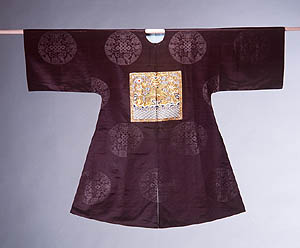
Civil official's surcoat:
This man's surcoat (bufu) has two court insignia
badges, front and back. They are embroidered with
a golden pheasant which represents a second-rank
civil official of the Qing dynasty. To become a
civil official it was necessary to pass a series
of rigorous imperial examinations. Rank was therefore
a sign of accomplishment and status. There were
nine grades of civil official (with one being the
most senior), represented by bird motifs. * Silk
and gold-wrapped thread embroidery, damask-weave
silk-satin, made in China in the late 1800s. Private
collection. Australia, Photo by Penelope Clay.
|
Formal
court dress
The emperor and court officials wore formal dress (chaofu)
at the most solemn state ceremonies such as accession
to the throne, imperial weddings, birthdays, New Year,
winter solstice and sacrifices to heaven and earth.
It was generally worn with a ceremonial collar (piling).
The
style was appropriated from Ming court dress, with the
addition of the distinctive Manchu horse-hoof cuffs,
plain cloth insertions at the sleeves and the collar.

Formal
court robe (chaofu): This lightweight
summer robe is made from gauze-weave silk and would
have been worn by a Qing dynasty official on formal
occasions. It is embroidered with a traditional
design of dragons, representing the emperor or Son
of Heaven, clouds, the Isles of the Immortals, crested
waves and deep water which together reflected the
Chinese conception of the cosmos. * Silk, embroidered
with silk and metallic thread, made in China during
the late 1800s to early 1900s. Powerhouse Museum
collection. Purchased 1955. A4564-1.
|
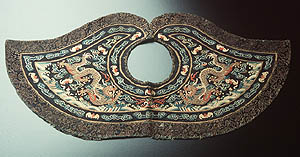
Ceremonial collar (piling):
This collar was a sign of honour. It was worn with
a formal Qing court robe (chaofu), surcoat,
hat and court beads. It fastened at the neck and
spread out across the shoulders. The right to wear
the collar was granted by the emperor. * Silk and
metal-thread tapestry-weave (kesi), silk
and gold-wrapped thread brocade, made in China in
the 1800s. Powerhouse Museum collection.
Gift of Miss B Shaw 1976. A6464.
|
Summer
and winter robes
Court clothing was divided into summer and winter dress.
Summer robes were made of gauze or lined with silk and
winter robes were padded with silk, or trimmed or lined
with fur.
The
emperor's formal winter court dress was further divided
into two forms. One was worn from the beginning of the
11th lunar month until the 15th day of the first lunar
month. The other was worn from the 15th or the 25th
of the ninth lunar month until the first day of the
11th lunar month. The date of seasonal change of dress
was decided by the Board of Rites and was issued as
an imperial edict.
|
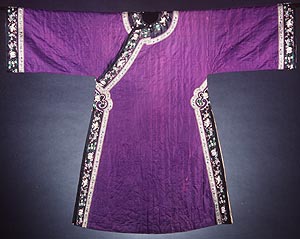
Manchu woman's winter robe: This
informal robe (changyi) is padded with
silk wadding for
warmth. The imperial capital in Peking is in the
far north of China and during winter temperatures
can drop to minus 20 degrees Celsius.
The
purple silk has a damask-weave design of dragon
medallions and the sleeves are lined with cream-silk
sleeve bands embroidered in polychrome floss silk
with flowers and butterflies. These were visible
when the elbow was bent. * Silk with floss-silk
embroidery, made in China during the late 1800s.
Powerhouse Museum collection.
Gift of Mrs C R Thornett 1967. H8187.
|
Manchu
women's informal dress
Manchu women's informal wear comprised two styles of
long robe known as changyi and chenyi,
which came into vogue during the reign of the Qianlong
Emperor (1736-95). Both robes were worn with a long
neck ribbon.
The
chenyi featured a round neck and a panel crossing
from left to right, fastening at the side with five
buttons and loops. It had a relatively straight body
and full sleeves. The changyi differed in that
it had splits up each side of the robe allowing facility
of movement. The splits were often highlighted by decorative
borders.
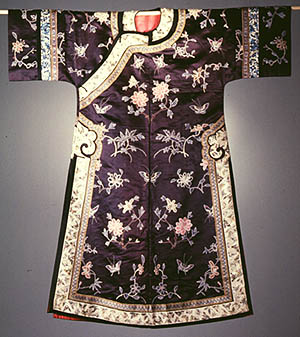
Floral pattern robe: This
informal Manchu woman's robe or changyi is
embroidered with a design of seasonal flowers and
butterflies. The butterfly is a symbol of summer,
joy and happiness in marriage. The motifs are embroidered
in Peking-knot stitch, a time consuming and exacting
embroidery technique. The subtle palette of colours
used in the embroidery harmonises beautifully with
the slate-grey ground. * Silk-satin with silk embroidery,
made in China during the late 1800s. Powerhouse
Museum collection. Purchased with funds donated
by Preston and Mary Saywell 1989. 89/497.
|
Activity
Identify two motifs used in formal court clothing. Explain
their meaning and draw a stylised version that may be
used on contemporary apparel.
Hats
Regulations governing court dress also included head
wear. Court officials' semi-formal hats were principally
distinguished by whether they were summer or winter
styles. Winter hats generally comprised a black skull
cap with upturned fur brim and summer hats were a conical
shape woven from strips of bamboo and edged with silk
brocade. The crowns of both hats were covered with a
red-twined or floss-silk fringe and topped by a knob
indicating the official's rank.
|
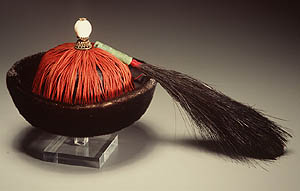
Official's winter hat:
The knob indicates that the wearer was a sixth-rank
official. Black silk satin with fur brim, made
in China in the late 1800s. Powerhouse Museum
collection. Gift of Mrs G W Biashicoff 1954. A4488
Peacock
feather hat attachment (hualing): These
plumes were a special distinction conferred by
the emperor. A single-eye plume was conferred
upon nobles and officials down to the sixth-rank.
Made in China in the late 1800s. Powerhouse Museum
collection. Gift of Mrs R D Conacher 1966. H7958
|
Foot
binding
The practice of foot binding was followed by most Han
Chinese women during the Qing dynasty (but not by Manchu
women). By restricting movement, bound feet deterred
women from leaving home and husband and encouraged a
compliant fidelity.
Bound
feet were also a sign of beauty and refinement which
enhanced the prospect of marriage. The swaying walk
of a woman with bound feet was considered particularly
alluring.
Activity
Choose one of the following:
1. Write an argument about foot binding.
2. Compare foot binding to modern day mutilation such
as piercing or tattoos.

Model: of the foot of a 15-year-old
female patient at a hospital in Canton, made from
a cast taken by T G Fawcett in 1874. Powerhouse
Museum collection. Gift of A Fawcett 1897, H1818.
|
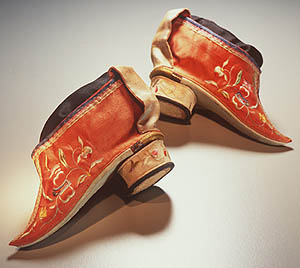
Bound feet shoes: cloth heel
and embroidered silk uppers, made in China about
1850. Powerhouse Museum collection. Gift of M Horn
1957, H5631. |
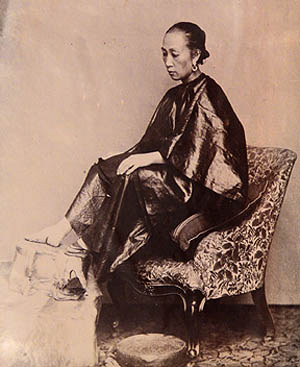
Image: woman with bound feet,
Southern China, about 1880. Powerhouse Museum collection.
96/66/1. |
|
Ankle
bindings (tuidai)
Girls' feet were bound when they were as young
as three. A long binding cloth was wrapped around
the foot with the aim of forcing the four small
toes under the foot and bringing the front of
the foot and the heel together. It was extremely
painful. Socks and then shoes were worn on top
of the bindings.
Activity
1. Using illustrations in your response describe
the effect of the Qing dynasty on:
- fabric
decoration
- weaving
- garment
styles
- accessories.
(200 words for each)
2.Explain
how clothing was influenced by:
- religion
- rank
- seasons.
(150 words each)
|
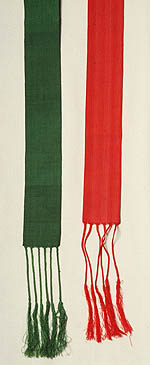
Decorative ankle bindings
such as these, also known as puttees, held
the shoes, socks and trouser legs in place.
* Silk, made in China in the late 1800s to
early 1900s. Powerhouse Museum collection.
Powerhouse Museum collection. Gift of Miss
E A MacDonald 1971. A5963-1:2
|
|
|